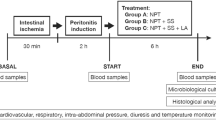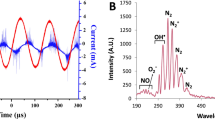Abstract
Background
Carbon dioxide (CO2) has been used in the food industry as an antimicrobial agent. This study aimed to investigate whether CO2 pneumoperitoneum might act similarly as an antimicrobial agent in the infected peritoneal cavity.
Methods
Peritonitis was induced in 58 rats by intraabdominal injection of an Escherichia coli inoculum (6 × 105 colony-forming units [CFU]/ml). Control rats were injected with saline solution. The rats were randomly divided into four groups: rat control (RC, n = 15), bacterial inoculation control (BIC, n = 10), bacterial inoculation and laparotomy (BIL, n = 17), and bacterial inoculation and CO2 pneumoperitoneum (BIP, n = 16). The survival rates and histopathologic changes in the abdominal wall muscles, spleen, liver, intestines, and omentum were evaluated, and the samples were classified as “preserved” or “inflamed” (acute inflammation or tissue regeneration).
Results
The survival rates for the four groups were as follows: RC (100%), BIP (75%), BIL (53%), and BIC (30%). With regard to survival rates, statistically significant differences were observed between the following groups: RC and BIC (p = 0.0009), RC and BIL (p = 0.0045), BIP and BIC (p = 0.0332), and RC and BIP (p = 0.0470). No significant differences regarding survival rates were observed between the BIL and BIC groups or between the BIP and BIL groups. With regard to the number of inflamed samples per group, a statistically significant difference was observed between the BIC and RC groups and the BIL and RC groups (p = 0.05).
Conclusion
Carbon dioxide pneumoperitoneum has a protective effect against bacterial peritonitis induced in rats.

Similar content being viewed by others
References
Geis WP, Kim HC (1995) Use of laparoscopy in the diagnosis and treatment of patients with surgical abdominal sepsis. Surg Endosc 9:178–182
Berci G (1993) Elective and emergent laparoscopy. World J Surg 17:8–15
Tang E, Ortega AE, Anthone GJ, Jr Beart BW (1996) Intraabdominal abscesses following laparoscopic and open appendicectomy. Surg Endosc 5:125–128
Balangué C, Taragoba EM, Pujol M, Folella X, Espert JJ, Trias M (1999) Peritoneal response to a septic challenge: comparison between open laparotomy, pneumoperitoneum laparocospy, and wall lift laparoscopy. Surg Endosc 13:792–796
Gurtner GC, Robertson CS, Chung CS, Hung CS, Ling SM, Lp SM, Li AK (1995) Effect of carbon dioxide pneumoperitoneum on bacteraemia and endotoxaemia in an animal model of peritonitis. Br J Surg 82:944–948
Targarona EM, Rodriguez M, Camacho M, Balagué C, Gich I, Vila L, Trias M (2006) Immediate peritoneal response to bacterial contamination during laparoscopic surgery. Surg Endosc 20:316–321
GilI CO, Delacy KM (1991) Growth of Escherichia coli and Salmonella typhimurium on high-pH beef packed under vacuum or carbon dioxide. Int J Food Microbiol 13:21–30
Schavion CA, Younes RN, Pollara WM, Itinoshe M, Birolini D (1998) Videolaparoscopia em ratos: um novo modelo experimental. Rev Col Bras Cir 25:111–112
Kaufmann F (1947) The serology of the coli group. J Immunol 57:71–100
Sack B (1980) Enterotoxigenic Escherichia coli: identification and characterization. J Infect Dis 142:279–286
Bier O (1975) Bacteriologia e imunologia em suas aplicações à medicina e à higiene, 16th edn. Melhoramentos-EDUSP, São Paulo, pp 171–172 ep 786–787
Reed LJ, Muench H (1938) A simple method of estimating fifty percent end points. Am J Hyg 27:493–497
Glantz SA (1996) Primer of biostatistics. McGraw-Hill, New York
Barros C, Sobrinho J, Ropoport A, Novo N, Azevedo JLMC, Sorbello AA (2009) Comparative study of the changes in partial pressure of plasma carbon dioxide during carbon dioxide insufflation into the intraperitoneal and preperitoneal spaces. J Laparoendosc Adv Surg Tech 19:345–349
Jacobi CA, Ordemann J, Bohm B, Zieren HU, Volk HD, Lorenz W, Halle E, Müller JM (1997) Does laparoscopy increase bacteremia and endotoxemia in a peritonitis model? Surg Endosc 11:235–238
Hart CD, Mead GC, Norris AP (1991) Effects of gaseous environmental and temperature on the storage behavior of Listeria monocytogenes on chicken breast meat. J Appl Microbiol 70:40–46
Marshall DL, Wiese-Lehigh PL, Well JH, Farr AJ (1991) Comparative growth of Listeria monocytogenes and Pseudomonas fluorecens on precooked chicken nuggets stored under modified atmospheres. J Food Protection 54:841–843
Lee L, Lencki R, Castaigne F (1995) A review on modified atmosphere packaging and preservation of fresh fruits and vegetables physiological basis and practical aspects: part I. Packaging Technol Sci 8:315–331
Lee L, Arul L, Lencki R, Castaigne F (1996) A review on modified atmosphere packaging and preservation of fresh fruits and vegetables: physiological basis and practical aspects: Part II. Packaging Technol Sci 9:1–12
Acknowledgments
We thank Fábio S. Goffi, Antonio Cláudio de Godoy, Renatto Andretto, Arnaldo Zanotto, and Nagamassa Yamagushi for their encouragement and support; Luci Ebisui and Raquel Guedes for technical support in the laboratory; Jeane G. Bronzatti for managing the supplies of the Hospital Alemão Oswaldo Cruz; Mr. and Mrs. Milton Ferraz Costa for managing the graphic composition; and the board of Endoview do Brasil Ltda.
Disclosures
Albino Augusto Sorbello, Joao Luiz Moreira Coutinho Azevedo, Junko Takano Osaka, Sueli Damy, Luiz Mattosinho França, and Erasmo Carlos Tolosa have no conflicts of interest or financial ties to disclose.
Author information
Authors and Affiliations
Corresponding author
Rights and permissions
About this article
Cite this article
Sorbello, A.A., Azevedo, J.L.M.C., Osaka, J.T. et al. Protective effect of carbon dioxide against bacterial peritonitis induced in rats. Surg Endosc 24, 1849–1853 (2010). https://doi.org/10.1007/s00464-010-0901-9
Received:
Accepted:
Published:
Issue Date:
DOI: https://doi.org/10.1007/s00464-010-0901-9




